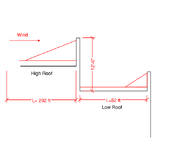Pratikmokal
Structural
- Sep 24, 2018
- 3

I have a situation with both a low and high roof, each with parapets. Upon reviewing the high roof parapet as a capture wall, I found its height insufficient to withstand the snow drift. According to ASCE 7-22, Figure C7.7-2, I am experiencing leeward snow drift; however, the code does not specifically address drift at the low roof parapet. Could you provide guidance on how to assess snow drift for the low roof parapet based on ASCE 7-22? Thank you.
